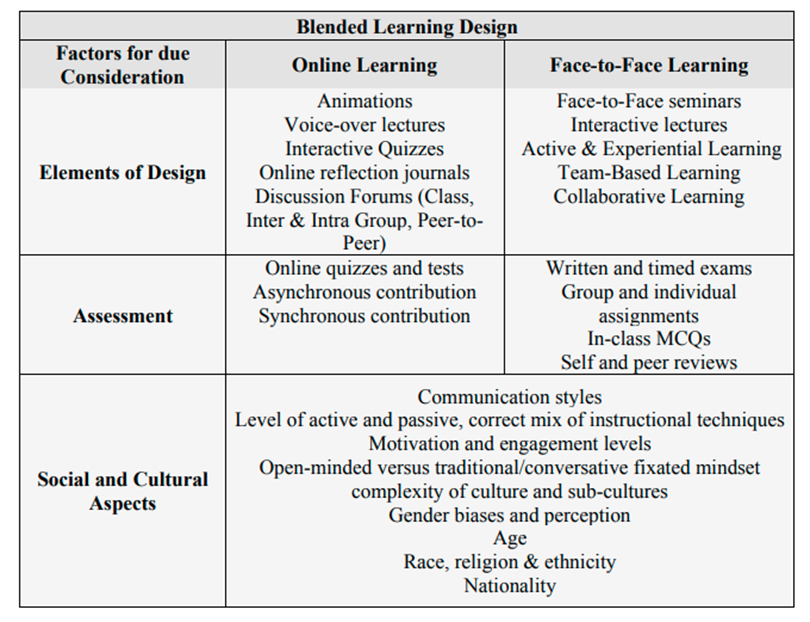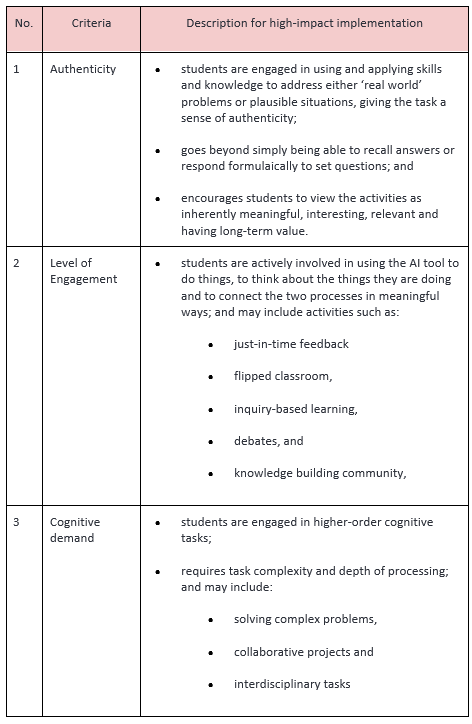The Innovative Teaching Excellence Award (ITEA) recognises distinguished achievements in developing innovative technology-enhanced teaching, including instruction, feedback, and assessment. The award seeks to promote thoughtful use of educational technologies and will recognise both individuals and teams, whether in a single course or a programme.
The award has two categories—Blended Learning (BL) and Artificial Intelligence (AI).
Definitions
The term ‘Innovative’, used within the context of this award, is defined as creating impactful, sustained approaches or solutions, using new or existing digital technologies, to advance the educational mission of NUS and enhance the learning of students, colleagues, and the wider university community.
‘Blended learning’ is defined as “the thoughtful integration of classroom face-to-face learning experiences with online learning experiences” (Garrison & Kanuka, 2004, p. 96). We consider ‘thoughtful integration’ as effectively incorporating (a) online learning and (b) in-class interactive learning in such a way that the two elements complement each other to provide learners with a deep and holistic learning experience.
We define ‘Artificial Intelligence’ broadly as “technology that can generate new and unique outputs”. AI-driven technology, such as generative AI applications – ChatGPT, Mid-journey, and GitHub Copilot, has the potential to promote personalised learning, create or revise teaching materials, develop coding for research, and generate prompted information in response to students’ inquiries. We adopt an augmentation perspective (Molenaar, 2022) as opposed to a replacement perspective on AI in education, implying that AI is used to optimise and augment human intelligence rather than replace it. As in blended learning, the focus on the interplay between learners, teachers, and AI to deepen learning will be central to the successful application of AI in teaching and learning.
Purpose
The purpose of the award is to encourage thoughtful integration of technology into teaching and learning. The award seeks to recognize colleagues who have used technology in innovative ways in order to advance their pedagogy by positively contributing to students’ learning. An ancillary goal is to encourage wider adoption of such thoughtful use of technology beyond a single course, i.e. within the department, programme, faculty, or the university more broadly.
The award is not intended to provide recognition simply for bringing and introducing technology into the classroom.
Categories and Focus
| Category 1: Innovative Teaching Excellence Award – Blended Learning (ITEA-BL) |
|
| Sub-categories: Individuals / Teams | |
| Focus | Description |
| Blended Learning | Recognises contributions by an individual or team to successful design, development, implementation, and evaluation of technology-enhanced teaching and assessment at the course or programme level, using blended learning strategies, in a creative and successful way, within NUS. |
| Eligibility |
|
| Entitlement | The award will carry a monetary value of $2,000 (individual category) and $8,000 (teams, to be awarded to team leader and distributed among team members). Recipients will be recognised at a university-wide Teaching Awards Ceremony to celebrate and share their achievements with the NUS community. |
| Criteria |
For impactful blended learning, it is important that the teachers analyse and identify the strengths and weaknesses of different face-to-face and online learning activities and find effective ways to integrate the benefits of the chosen learning activities to bring about a desirable blend.
The table below provides non-exhaustive example of teaching and learning design elements for consideration in Points (1) and (2) above.
|
| Documentation and Submission Process |
Applicants will submit a portfolio consisting of: A. An impact narrative (1000 words) centred on the blended learning course, articulating the three aspects:
B. Curated Course Video: A compilation of:
C. BL2.0 Self-declaration Checklist Submit the filled form as a supplementary document in your application.
|
| Category 2: Innovative Teaching Excellence Award – Artificial Intelligence (ITEA-AI) |
|
| Sub-categories: Individuals / Teams | |
| Focus | Description |
| Artifical Intelligence | Recognises contributions by an individual or team to successful design, development, implementation, and evaluation of technology-enhanced teaching and assessment at the course or programme level, using artificial intelligence, in a creative and purposeful way, within NUS. |
| Eligibility |
|
| Entitlement | The award will carry a monetary value of $2,000 (individual category) and $8,000 (teams, to be awarded to team leader and distributed among team members). Recipients will be recognised at a university-wide Teaching Awards Ceremony to celebrate and share their achievements with the NUS community. |
| Criteria |
We propose that faculty members provide a pedagogically sound and evidence-based implementation write-up (impact narrative) in relation to the following criteria:
|
| Documentation and Submission Process |
Applicants will submit a portfolio consisting of: 1. Teaching statement (1000-1500 words). The statement should consist of a teaching philosophy and one impact narrative that together make an evidence-informed case for the award. This reflective statement needs to articulate the individual or team’s strength, based on the pedagogical rationale for using AI in teaching, educational design, assessment, or feedback in the specific case being made. It should do so by demonstrating alignment with the criteria and explaining how as well as why the AI-integrated pedagogical practice exemplifies the achievement. 2. (optional) 3 to 5-minute video that demonstrates the teaching innovation (i.e. the actual application of AI in teaching and learning). In the case of teams, the submission must be made by the team leader. The documentation should highlight the way the team collaborated on a common purpose and spell out the different contributions of team members.
|





































































